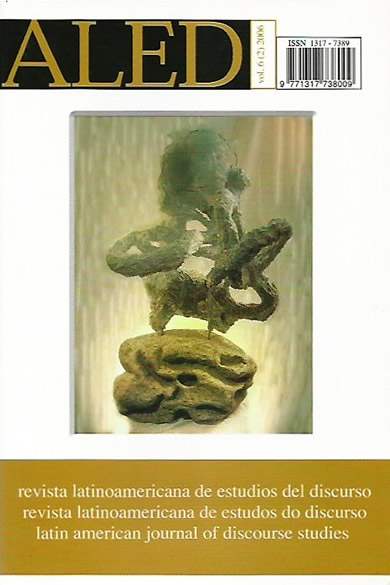La cumbia villera (en)red(ada) en el discurso
Una introducción al monográfico sobre cumbia villera en la Argentina
Keywords:
cumbia villera. social crisis. culture. intercultural dialogue. social networks. ideology.Abstract
Excluded groups are able to create non hypocritical cultural manifestations in historical moments of social crisis as happened at the end of the XIX century with the tango in Buenos Aires and with the cumbia villera at the end of the XX century in the poor neighborhoods of Argentina when liberalism was most vigorous. In this theoretical paper that not only introduces the subject but also this monograph our hypothesis is that language constitutes the most important instrument to impose the value of signs. The analysis of the musical manifestation cumbia villera also shows how individuals move themselves in social networks and look for new identities, thus giving evidence in favor of culture as intercultural dialogue. However, the dominant discourse may reduce a sign that alters its status quo as it questions its values.
Downloads
References
ALTHUSSER, L. (1970/1988) Ideología y aparatos ideológicos del Estado. Buenos Aires: Nueva Visión.
BARTHES, R. (1980) Mitologías. Méjico: Siglo XXI.BAUDRILLARD, J. (1990) Revenge of the Cristal. London, Concord, Mass: PlutoPress.
BEHARES, L. E., MASSONE, M. I. & CURIEL, M. (1990) ‘El discurso pedagógico de la educación del sordo. Construcciones de saber y relacionesde poder’, en Cuadernos de Investigación del Instituto de Ciencias de la Educación, Universidad de Buenos Aires 6: 41-68.
BENVENISTE, E. (1966) Problèmes de linguistique générale. Paris: Éditions Gallimard.
BOURDIEU, P. (1999) Intelectuales, política y poder. Buenos Aires: Eudeba.
DURKHEIM, E. (1976) Educación como socialización. Salamanca: Sígueme.
FISHMAN, J. (1968) ‘Nationality-Nationalism and Nation-Nationism’, en J.Fishman, Ch. Ferguson y J. Das Gupta (eds.) Language problems in developing Nations. New York: John Wiley and Sons Inc.
GEERTZ, C. (1987) La interpretación de las culturas. Barcelona: Gedisa.
GOFFMAN, E. (1975) Stigmate. Paris: Éditions de Minuit.
GUMPERZ, J. (1968) ‘The speech community’, en International Encyclopedia ofthe Social Sciences, pp 381-386. London: Macmillan.
GUMPERZ, J. (1962) ‘Types of linguistic communities’, en AnthropologicalLinguistics 4 (1): 28-40.
HARDT, M. & NEGRI, A. (2002) Imperio. Buenos Aires: Paidós.
HEIDEGGER, M. (1993) El ser y el tiempo. Madrid: Fondo de CulturaEconómica.
HOBSBAWN, E.J. (1994) La edad de los extremos. Barcelona: Crítica.
HYMES, D. (1962) ‘The ethnography of speaking’, en T. Gladwin y W. C.Sturtevant (eds.) Anthropology and Human Behavior. Washington, DC,Anthropological Society of Washington.
JAMESON, F. & MIYOSHI, M. (eds). (1998) The cultures of globalization.Durham and London: Duke University Press.
KLUCKHOHN, C. (1962) Culture and behavior. New York: The Free Press.LABOV. W. (1972) Language in the inner city: Studies in the Black English Vernacular. Philadelphia: University of Pennsylvannia Press.
LACAN, J. (1975) Intervención sobre la transferencia. México: Siglo XXI.
LUCKMAN, T. (1970) ‘On the boundaries of social world’, en M. Natanson(ed.) Phenomenology and social reality. The Hague: Martinus Nijhoff.
MARX, K. (1975) El Capital. Tomo I. vol. I. México: Siglo XXI.
MASSONE, M. I. (2006) ‘Ideologic sign in deaf educational discourse’, en C.Plaza Pust y E. Morales López (eds.) Sign languages in contact. Amsterdam:John Benjamins (en prensa).
MASSONE, M. I., ROMÉ, N. & BUSCAGLIA, V. (2004) ‘Prisoners minorizedby force and communion’. Manuscrito.
MASSONE, M. I., CURIEL, M., BUSCAGLIA, V., FAMULARO, R., SIMÓN,M. & CARBONI, I (2000)La Conversación en la Lengua de Señas Argentina.Buenos Aires: www.librosenred.com.
MASSONE, M. I. & SIMÓN, M. (2000) ‘Los efectos significantes tr- en laeducación de sordos’, en Jornada de Capacitación y Formación, Comunidad,Tucumán.
MASSONE, M. I. & MACHADO. E. M. (l994) Lengua de Señas Argentina.Análisis y vocabulario bilingüe. Buenos Aires: Edicial.
MILROY, J. (1978) ‘Lexical alternation and diffusion in vernacular speech’ enBelfast Working Papers in Language and Linguistics 3: 101-114.
MILROY, J. & MARGRAIN, S. (1978) ‘Vernacular language loyalty and socialnetwork’, en Belfast Working Papers in Language and Linguistics, 3: 101-114.
PARDO, M. L. (2004) ‘Introducción al concepto de globalización desde LatinoAmérica’, en L. Sklair Una sociología de los sistemas globales. Buenos Aires:Gedisa.
PARDO, M. L. (2003) ‘La identidad personal y social de los indigentes en sudiscurso. Un Análisis Crítico del Discurso neoliberal en la Argentina y sus consecuencias’, en L. Berardi, Análisis Crítico del Discurso. Perspectivaslatinoamericanas. Santiago de Chile: Frasis Editores.
PARSONS, T. (1973) ‘Culture and social system revisited’, en L. Schneider. &C. Bonjean (comp.) The idea of culture in the social sciences. New York: Cambridge University Press. PRATT, M.L. (1987) ‘Linguistic utopias’, en N. Fabb & A. Duranti (eds.)Linguistics of Writing, pp 48-66.Manchester: Manchester University Press.
RAITER, A. (1999) Lingüística y política. Buenos Aires: Biblos.
SKLAIR, L. (1998) ‘Social movements and global capitalism’, en F. Jameson &M. Miyoshi (eds) The cultures of globalization, pp. 291-311. Durham and London: Duke University Press.
ULLÚA, E., PUCCIO CALVO, A.R. & MASSONE, M.I. (1996) ‘Prisoners asa minority minorized by force and communion’, en Proceedings SALSA IV, Symposium about Language and Society-Austin, pp. 95- 115.
VIRNO, P. (2003) Gramática de la multitud. Buenos Aires: Colihue.
ZIZEK, S. (2003) ‘El espectro de la ideología’, en S. Zizek (comp.) Ideología. Unmapa de la cuestión. México: Fondo de Cultura Económica.
Downloads
Published
How to Cite
Issue
Section
License

This work is licensed under a Creative Commons Attribution-NonCommercial-NoDerivatives 4.0 International License.
The authors retain the copyright and guarantee RALED the right to be the first publication of the work as well as a Creative Commons Attribution License that allows others to share the work with recognition of authorship and the initial publication in this journal.




